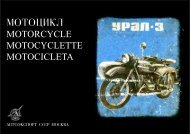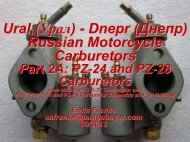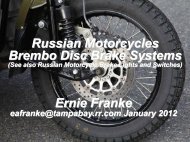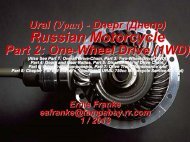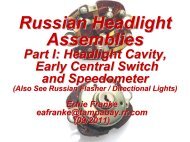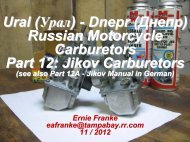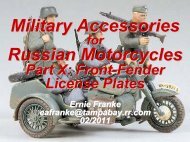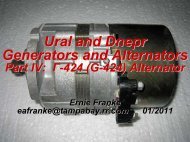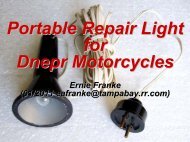K-63 Carburetor - Good Karma Productions
K-63 Carburetor - Good Karma Productions
K-63 Carburetor - Good Karma Productions
- No tags were found...
You also want an ePaper? Increase the reach of your titles
YUMPU automatically turns print PDFs into web optimized ePapers that Google loves.
Ural (Урал(Урал) - Dnepr(Днепр)Russian Motorcycle<strong>Carburetor</strong>sPart 7: K-<strong>63</strong> K<strong>Carburetor</strong>(see also Part 7A- Pekar K-<strong>63</strong> KCarbs and Part 7B- Setting K-<strong>63</strong> KCarbs)Ernie Frankeeafranke@tampabay.rr.com09/2012
K-<strong>63</strong> <strong>Carburetor</strong>• Common <strong>Carburetor</strong>s Found on Urals and Dneprs• K-<strong>63</strong>Ф (K-<strong>63</strong>F in English) Introduced to Dnepr K-750M and Later to MT-12• K-<strong>63</strong>T (most popular) Introduced in 1985 on Dnepr MT-11 and MT-12• К-<strong>63</strong>У (K-<strong>63</strong>U in English) Introduced to Modern (8.101) Urals in 1998• Significant Improvement Over Predecessor K-301 / K-302• Similar to K-62 <strong>Carburetor</strong>–Enrichener Added for Cold-Start Prime (twist up ¼ turn to lock)• Very Reliable, but Needs Setting Often to Remain in Peak Condition• Left and Right-Hand Versions Identical• Flange Bolts Directly on Cylinder Head• Later Replaced with K-65• Re-Build and Repair Kits Readily AvailableThe K-<strong>63</strong> carburetor predominantly appeared in the late 1980’s,on Dnepr MT-16 and MT-11 and modern Ural 8.103 (650 cc).
Russian <strong>Carburetor</strong> Time-Line(09/2012)K-37 (M-72)K-38 (K750, M-61, M-62, M-<strong>63</strong>)K-301Б (M-<strong>63</strong>, M-66, K-650/MT-8/MT-9)K-301В (M-<strong>63</strong>, MT-10)CVK32 Keihin (8.103 (650 &75 0cc),8.107)K-301Г (M-<strong>63</strong>, M-66, M-67, M-67.36)K-301Д (MT-10, MT-10.36,MB-650M, K-650/MT-8/MT-9,MT-16)K-37 K-37A1940 1945 1950 1955196019651970K-<strong>63</strong>/K-65 (K-750, MB-650,MT-11, MT-12, MT-16)K-37A (M-72, M-72K, M-72M,M-72H, K-750, MB-750)K-38K-302 K-62 K-<strong>63</strong>/K-65K-68K-301K-302 (K-750, MB-750,K-650/MT-9,MT-10, MT-11, MT-12, IMZ-8.103)K-62 (M-<strong>63</strong>, MB-650, MT-11 ,MT-16)28 mm Mikuni (8.103)K-68 (MB-650, MT-11, MT-16)Jikov 2928CE (Urals Exported to U.K.)1975UralsLast of the Dneprs1975 1980 1985 199019952000 20052010We have seen the gradual migration of the K-37 to the K-37Aand then the K-38. The K-301 went through several iterationsbefore the K-302 came along, followed by the K-Series carburetors.
Table I: KMZ (KM(KMЗ) - Dnepr (Днепр(Днепр) Sidecar Model/Year vs. Engine and Carb(09/2012)ModelUseYearEngine Size( cm 3 / inch 3 )CompressionRatioHorse PowerBHP (hp / kW)Max Power( rpm )Voltage<strong>Carburetor</strong>M-72Military1952-56746 / 45.3 SV5.5:122 / 16.24,500-4,8006-VoltK-37A (1950)M-72HMilitary1956-59746 / 45.3 SV5.5:122 / 16.24,500-4,8006-VoltK-37A (1950)K-750Military1959-<strong>63</strong>746 / 45.3 SV6.0:126 / 19.14,600-4,8006-VoltK-37A (1950),K-38K-750MMilitary19<strong>63</strong>-77746 / 45.3 SV6.0:126 / 19.14,500-4,8006-VoltK-37A, K-302, K-<strong>63</strong>ФMB-750Military 2WD1964-73746 / 45.3 SV6.0:126 / 19.14,600-4,9006-VoltK-37A, K-302K-650/MT-8Civilian1967-70649 / 39.4 OHV7.0:132 / 23.55,000-5,2006-VoltK-301Б, K-301ДK-650/MT-9Civilian1971-74649 / 39.4 OHV7.0:132 / 23.54,800-5,2006-VoltK-301, K-301Б,K-301Д, K-302MB-750MMilitary 2WD1973-77746 / 45.9 SV6.0:126 / 19.14,500-4,9006-VoltK-302MT-10Civilian1973-76649 / 39.4 OHV7.0:1(7.5:1)32 / 23.5(36 / 26.5)5,600-5,80012-VoltK-301В, K-301ДMB-650MMilitary 2WD1969-1974649 / 39.4 OHV7.5:136 / 26.55,000-5,20012-VoltK-301ДMT-10.36Civilian1976-87649 / 39.4 OHV7.0:1(7.5:1)32 / 23.5(36 / 26.5)5,600-5,80012-VoltK-301ДMT-12Civilian 2WD1977-85746 / 45.3 SV6.0:126 / 19.15,000-5,8006-VoltK-302, K-<strong>63</strong>ФMB-650Civilian 2WD1968-91649 / 39.4 OHV7.0:132 / 23.55,000-5,20012-VoltK-301, K-62,K-<strong>63</strong>T (1985),K-65T, K-68MB-650-M1Military(MT-16)1985-2007649 / 39.4 OHV7.0:132 / 23.55,000-5,20012-VoltK-301БMT-16(Dnepr-16)Civilian &Military 2WD1985-2005649 / 39.4 OHV7.0:1(7.5:1)32 / 23.5(36 / 26.5)5,600-5,90012-VoltK-301Д, K-62,K-<strong>63</strong>T (1985),K-65T, K-68MT-11(Dnepr-11)Civilian1987-2005649 / 39.4 OHV7.0:1(7.5:1)32 / 23.5(36 / 26.5)4,800-5,20012-VoltK-301Д, K-302,K-62, K-<strong>63</strong>T (1985),K-65T, K-68Dnepr principally used the K-<strong>63</strong>T carburetor in the MT-11 and MT-16.
Table II: IMZ (ИМЗ(ИМЗ) - Ural (Урал(Урал) ) Sidecar Model/Year vs. Engine and <strong>Carburetor</strong>(09/2012)ModelUseYearEngine Size( cm 3 / inch 3 )CompressionRatioHorse PowerBHP (hp / kW)Max Power( rpm )Voltage<strong>Carburetor</strong>M-72Military1941-56746 / 45.3 SV5.5:122 / 16.24,500-4,8006-VoltK-37, K-37A after 1950M-72KMilitary1954-60746 / 45.3 SV5.5:122 / 16.24,500-4,8006-VoltK-37A (1950)M-72MMilitary1956-60746 / 45.3 SV5.5:122 / 16.24,500-4,8006-VoltK-37A (1950)M-61Civilian1958-60649 / 39.4 OHV6.2:128 / 20.64,800-52006-VoltK-38M-62Civilian1961-65649 / 39.4 OHV6.2:128 / 20.64,800-5,2006-VoltK-38M-<strong>63</strong>(Ural-2)Civilian1965-68649 / 39.4 OHV7.0:132 / 23.55,200-5,8006-VoltK-38, K-301, K-301Б,K-301B, K-301Г, K-301Д,K-62M-66(Ural-3)Civilian1968-72649 / 39.4 OHV7.0:132 / 23.55,600-5,9006-VoltK-301, K-301Б,K-301ГM-67Civilian1973-75649 / 39.4 OHV7.0:132 / 23.55,000-5,20012-VoltK-301ГM-67.36Civilian1976-95649 / 39.4 OHV7.0:136 / 26.54,600-4,90012-VoltK-301Г8.103, 8.107Series “650”Civilian1994-2002649 / 39.4 OHV7.0:136 / 26.55,000-5,20012-VoltK-302, K-<strong>63</strong>Y,28mm Mikuni (1994),Keihin CVK32 (2000)8.103“750”SeriesCivilian2003-present745 / 45.2 OHV8.6:145 / 295,60012-VoltKeihin CVK32 (2000)Ural used the К-<strong>63</strong>У (K-<strong>63</strong>U in English) carburetor in early versionsof its 8.103 Series “650 cc”.
1. Steady-StateStateAdjustment Screw(Idle Adjust)5. Throttle Cap6. Throttle SpringHorizontal FlangeManifold MountK-<strong>63</strong> Parts DiagramFigure 126. Throttle Cable Guide25. Lower-Limit Limit Throttle Valve Travel(discard after engine break-in)10. Flat-Slide Throttle Valve24. Throttle Jet Needle Bar (Cleat)12-14. 14. Tickler23. Enrichener (Cold-Start)28. Floats29. Float Axle11. Fuel Feed Fitting16. Idle MixtureAdjustment Screw17. Idle MixtureAdjustment SpringSpigotAir Intake21. Starter Jet30. Float Valve31. Gasket32. Float Chamber18. Idle Jet19. Needle Jet Assembly
Fuel Feed FittingK-<strong>63</strong> <strong>Carburetor</strong>sSteady-StateStateAdjustment Screw(Idle Adjust)Enrichener (Cold-Start)Flange to CylinderTicklerSpigot Air IntakeFloat ChamberIdle MixtureAdjustment ScrewEnrichener (a.k.a. Choke)Pull Up and Rotate 90° to Enable.Disable (Un-twist and Release) Soonafter Warm-Up!
Characteristics: Round-Slide vs. Flat-Slidevs. Butterfly Throttle Valves•Round-Slide Throttle Valve–K-37 / K-38 / PZ-28D–K-68–Kaptex VDC-RAM (Ukrainian copy of Pekar K-68)–Mikuni VM-28–Jikov 2928•Flat-Slide Throttle Valve–K-301 / K-302–K-62 / K-<strong>63</strong> / K-65•Butterfly Throttle Valve–Keihin CVK32One term describing carburetors is round-slide,flat-slide or butterfly throttle valves.
Characteristics: Flange vs. Spigot Intake Manifold Mount•Flange-Mount–Bolts Directly on Cylinder Head or Adapter•K-37 / K-38 / PZ-28D•K-301 / K-302•K-62 / K-<strong>63</strong> / K-65 / K-68•Kaptex VDC-RAM (Ukrainian copy of Pekar K-68)•Spigot-Mount–Rubber Compliant Mount to Cylinder Head–Mikuni VM-28–Jikov 2928CE–Keihin CVK32Another term describing carburetors isflange-mount or spigot-mount.
Characteristics: Vertical vs. Horizontal Flange-Mount•Vertical Mounting Holes–K-37 / K-38 / PZ-28D, K-301 / K-302•Horizontal Mounting Holes–K-62 / K-<strong>63</strong> / K-65 / K-68–Kaptex VDC-RAM (Ukrainian copy of Pekar K-68)•Transition from Vertical-to-Horizontal–Used to Transition from Older K-37/38 and K-301/302 Carbs to ModernK-62 / K-<strong>63</strong> / K-65 / K-68 Carbs–Adapter Plates Readily AvailableAn adapter plate is needed to upgrade older motorcyclesto the modern horizontal pattern for the K-<strong>63</strong> / K-65 / K-68 type carbs.
K-<strong>63</strong>T <strong>Carburetor</strong> on Dnepr MT-11 and MT-16The K-<strong>63</strong>T, unlike somecarburetors, is identical“left” or “right”.Note: Extra heatinsulatinggaskets nextto the flange adapters.Vertical-to-HorizontalAdapterK-<strong>63</strong>T: 1107010The MT-11 and MT-16 maintenance manuals show the adapter platesneeded to transform the vertical mounting pattern used by theK-37/K-301 carbs to the K-<strong>63</strong> horizontal mounting pattern.
Characteristics: In-Line vs. Off-Axis Float Chamber Mount•Older Float Chamber (Bowl) Offset from <strong>Carburetor</strong> Body–Vertical vs. Slanted Float Chamber (Bowl) Mount•Vertical: K-37 / K-37A / K-38 / PZ-28D, K-301 / K-302K-37K-37APZ-28DK-38K-301K-302•Modern Float Chamber (Bowl) In-Line with Center of <strong>Carburetor</strong> Body–K-62 / K-<strong>63</strong> / K-65 / K-68, Mikuni VM-28, Jikov 2928CE, Keihin CVK32K-<strong>63</strong>K-65K-68MikuniVM-28KeihinCVK32Older Russian carburetors had external float bowls, with some builton a slant, with greater foaming of the fuel under vibration.
Characteristics: Left-or Right-Hand vs. Similar Construction• Left-Hand or Right-Hand Construction (mixture-adjust on opposite sides)–K-37 / PZ-28D, K-301 / K-302, K-68, Kaptex VDC-RAM (Ukrainian Copy of Pekar K-68)PZ-28DK-301K-302K-68• Identical Construction (mixture-adjust on same side, top or bottom)–K-62 / K-<strong>63</strong> / K-65, Mikuni VM-28, Keihin CVK32 (L22A)K-<strong>63</strong>K-65MikuniVM-28KeihinCVK32A few Russian carburetors (L/R) were built so that themixture-adjust screw was always on the outside.
K-<strong>63</strong> <strong>Carburetor</strong> Construction (Figure 2)• K-<strong>63</strong> Construction Similar to K-62• <strong>Carburetor</strong> Consists of Three Main (cast zinc alloy) Parts;–Body (8), Float Chamber (bowl) (38) and Throttle Cover (4)• Float Chamber (38)–Breathing Hole Connected to External Environment via Opening (26)–Float Mechanism Consists of Two, Rectangular, Lever-Type Floats (18), Connected by a CommonShaft (axle) (10)–Float and Lever Made of One-Piece Plastic–Level of Fuel in Float Chamber Approximately the Same as in the K-62• When <strong>Carburetor</strong> Upside Down, Molding Line on Side of the Float Should be Paralleland 13 ± 1 mm to the Plane–Drain Hole (21) In Lid of the Float Chamber• Fuel Valve (20)–Designed as Brass Needle which Rests on the Bottom of the Float Plate–Top Closes the Fuel Supply Channel–Disc of Elastic Material In Upper Cone of Fuel Valve (20)–Level of Floats in the Chamber (bowl) Controlled by Bending the Supporting Plate Tab• Mixture Enrichener System (starter)–Before Starting a Cold Engine, Lever (31) or Bent Stick Raises Piston (34)–Fuel mixture from the Enrichener (starter) to Mixing Chamber Enters thru Channel (17)–Under the Influence of Vacuum, Formed when Turning Kick-Starter, Fuel Flows thru Starter Jet (37)–Spring (33) Prevents Conical Needle (36) from Sticking• Throttle Valve (11)–Vertical, Flat, U-shaped Cross-Section of Sheet Brass–In Wall, Facing the Air Cleaner, the Bottom Is Cut on a Semi-Circular Radius to Provide Air/FuelMixture when Idling• Throttle Jet (metering) Needle (25)–Made of Brass or Stainless Steel–Upper Part Has a Thread to Move to Change the Amount of Spray–Metering Needle Can Be Raised or Lowered by Loosening the Lock-Nut (5) and Screwing or Twistingthe Throttle Needle (25) in the Needle Bar (6)–Need for Such Adjustments May Occur Under Seasonal Operation, Break-In Period, or In Conditionsof High Temperature or Altitude (mountains)–Each Full-Turn Moves the Needle by 0.5 mm
K-<strong>63</strong> <strong>Carburetor</strong> Construction (Figure 2)• At Low-Speed• Cylinders Need a Rich Mixture, When Idle Throttle Screw (28) Is Slightly Screwed In• Mixing Occurs in the Mixing Chamber thru the Emulsion Hole (22), from Fuel Leaving the Idle (pilot)Jet (15) and Air Coming thru Air Channel (30)• In the First Quarter of the Throttle (when the throttle is lifted)–When Lifting the Throttle Up to a Quarter, the Mixture Composition Is Determined by System Idling–Idle Jet (15) Fuel Fed Directly from the Float Chamber thru Emulsion (22) and Transition (23) Holes–Vacuum in the Air Tube (12) Increases–Fuel Is Discharged from the Float Chamber thru the Main Jet (14) to the Annular Cavity between theJet Needle (25) and the Walls of the Air Tube into the Air-Flow of the Main Air Duct–Here, Fuel is Sprayed, Partially Evaporating and Entering the Cylinder–Composition of the Mixture Is Controlled by Idle Mixture Screw (29) and Idle Speed Adjust Screw (28)• With Mixture Screw Turned Out (CCW) (29) Mixture Is Depleted (leaner)• Turned In (CW) Mixture Is Enriched (richer)–Best Composition of Fuel/Air Mixture Depends on Position of Conical Jet Needle (25), the Capacity ofthe Main Jet (14) and the System Idling System–Jet Needle (25) Provides Necessary Fuel Supply Over Most of Throttle Range, Corresponding to about¼ to 3/4 of Range–Since Moving Jet Needle Up Increases the Area of Annular Cross-Section between the Jet Needle andthe Air Tube, and Consequently the Fuel• In the Last Quarter of the Throttle–Flow Area of Air Channel in Spray Zone Varies Relatively Little, so Air Flow Remains AlmostUnchanged–Amount of Fuel Supplied Determined Mainly by Diameter of Main Jet (14)–Air Entering thru Channel (9) of Main Nozzle (12) in the Annular Gap between the Nozzle and Body,Substantially Improves Mixing
K-<strong>63</strong>F,T,YF,T,Y (Ф, Т, У) <strong>Carburetor</strong> Construction (Figure 2)1. Fitting with Lock-Nut 20. Fuel Valve2. Throttle Spring 21. Drain Hole3. Max Throttle Travel Limiter 22. Emulsion Hole(remove after engine break-in)4. Throttle Housing Cover 23. Transition Hole5. Jet Needle Lock-Nut 24. Air Channel Idle Jet6. Metering Needle Bar (Cleat) 25. Conical Throttle Jet (Metering) Needle7. Throttle Valve 26. Float Chamber Vent8. Main Housing (block) 27. Fuel Input Fitting9. Air Channel Dispenser 28. Idle Speed Adjust Screw10. Float Arm Axle 29. Fuel/Air Idle Mixture Adjust Screw11. Body 30. Air Channel12. Main Nozzle (Air Tube) 31. Enrichener (starter) Lever13. Float Chamber Cover 32. Enrichener Rod14. Main Jet 33. Spring15. Idle (pilot) Jet 34. Enrichener (starter) Piston16. Lock Washer 35. Tickler Float17. Channel for Supplying Fuel Mixture from Enrichener 36. Needle Plunger18. Float 37. Starter Jet19. Fuel Valve Stop (Reference to Adjust Fuel Level) 38. Float Chamber (bowl)26. Breathing HoleNeedleJetAssembly25. Jet Needle35. Tickler21. Float Chamber Drain Hole 17. Enrichener Mixture Channel18. Dual Floats
K-<strong>63</strong> <strong>Carburetor</strong> Construction (Figure 2)• Tickler (cold-start) (35)–Ensures Desired Mixture when Starting a Cold Engine (
Tickler and Enrichener (Cold-Start) for the K-<strong>63</strong> K<strong>Carburetor</strong>Starting Device Enrichener or Choke):1. Stem2. Rail3. Spring4. Plunger Tube5. Piston6. Lock Washer7. Sealing Washer8. Needle17. Channel for Supplying Fuel Mixture from Enrichener18. Float21. Drain Hole22. Emulsion Hole31. Starter Lever32. Rod33. SpringEnrichener34. Plunger Launcher35. Tickler36. Needle Plunger37. Fuel Injector LauncherEnrichener (a.k.a. Choke)Pull Up and Rotate 90° to Enable.Disable (Un-twist and Release)Soon after Warm-Up!35. Tickler17. Enrichener Mixture ChannelBefore starting a cold engine, lever (31) raises piston (34). Under the influence of vacuum,formed for the throttle when turning the kick-starter, fuel flows through the nozzle (37)in the cavity under the plunger. Here it is mixed with air, which goes through a channelto the inlet pipe of the carburetor, then in the form of a rich emulsion is directed throughchannel (17) in the mixing chamber and then into the engine cylinder. When fullyraised, the plunger reaches the maximum enrichment of the mixture, based on the limitedcapacity of the nozzle (37). When fully retracted, the plunger needle closes the fuel feed andfuel supply is stopped. Tickler (35) is momentarily pushed to bypass the float valve andprovide a rich fuel mixture from the float chamber.
Throttle SpringK-<strong>63</strong>У (U) <strong>Carburetor</strong> in the MT-11/ MT-16Control Cable ConduitFlat-Slide Throttle ValveFloat ChamberAir IntakeFloat Chamber GasketEnrichener (Cold-Start)49Throttle Chamber GasketAir/Fuel Exhaust to Cylinder14FloatItem #-123567810111213151617181919202122N/A23242526272829303132Part NumberK<strong>63</strong>T-1107010K<strong>63</strong>У-1107925K62-1107055900902-0K<strong>63</strong>У-1107511K<strong>63</strong>У-1107506K62-1107048K62-1107052K<strong>63</strong>У-1107892K<strong>63</strong>У-1107894K<strong>63</strong>У-1107890N/AK30-1107130K30-1107130K30-1107115220082K23-59907103-0K62-1107205K<strong>63</strong>T-1107186K34Б-1107186K<strong>63</strong>У-1107170K<strong>63</strong>-1107185K62-1107044K62-1107047K<strong>63</strong>-1107690N/AN/AK62-1107525K60-1107527K62-1107640K62-1107661K62-1107675K62-1107053K62-1107128Part Description<strong>Carburetor</strong>Steady-State Idle Adjust ScrewScrewWasherSpringThrottle CoverThrottle SpringThrottle GasketNeedleStrap (Bar)Throttle ValveFuel Input FittingDepressor (Tickler) KnobDepressor (Tickler) StemDepressor (Tickler) SpringScrew, M5-6gx20Idle Stroke ScrewIdle Screw SpringIdle JetMain Fuel JetMain Fuel JetMain System AtomizerEnrichener JetEnrichener SpringGuide SpringCorrector-EnrichenerThrottle Needle LockLower-Limit Throttle Valve Travel(remove after engine break-in)Guide Wire AssemblyCoverFloat assemblyAxleNeedle valve AssemblyFloat Chamber GasketFloat ChamberThe breakdown of the K-<strong>63</strong> carb shows the flat-side throttle valve, andflange-mount. The part numbers clearly show a heritage to the K-62.
<strong>Carburetor</strong> K-<strong>63</strong> KAdjustment (moto4you.ru) (see Figure 2)• Initial Checks and Adjustments–Before Checking the <strong>Carburetor</strong>• Check / Adjust Spark Plug Electrode Gaps• Check / Adjust Ignition Breaker Points• Check / Adjust Clearances between Valve Stems and RockerEnds• Idling Speed Adjustment–First, Ensure There Is Clearance (Gap) between Cable SheathEnd-Piece and Union of 2-3 mm–If Not, Loosen the Lock-Nut Socket of Union (1) and Rotate ItClockwise or Counterclockwise, Adjusting the Proper Gap andThen Secure the Lock-Nut (5)•<strong>Carburetor</strong> Adjust for Idle (Low-Speed)1. SynchronizationAdjuster29. Idle MixtureAdjuster28. Idle SpeedAdjuster–If Warm Engine Stops at Minimum Idling Speed without a Load, Must Adjust Carb Idle–Adjust Each <strong>Carburetor</strong> Individually, Disabling the Other Cylinder–Idle Adjustment Procedure• Adjust Idle Screw (28) to Set a Minimum Sustained Speed, then Slowly Unscrew (CCW) Idle MixtureScrew (29) until It Misses (misfires), then Slowly Turn the Screw In (CW) until Engine Starts toOperate Steadily• Then Screw (28) Again to Reduce Throttle to Obtain the Minimum Sustainable Speed, at the SameTime Adjusting Mixture Screw (29)• These Operations are Repeated Three or Four Times until Minimum Sustained Speed Is Achieved• Similarly, Adjust the <strong>Carburetor</strong> of Other Cylinder•Synchronizing Engine Idling Speed–After Adjusting, Idle Speed when Using Either Left or Right Cylinders Should Be the Same–Checked by Ear, Alternately Disabling Left and Right Cylinders–By Lifting the Cap from the Spark Plug or By Shorting Out the Spark Plug to Ground–If Engine Speed Varies When Shifting between Left and Right Cylinders, Adjust Screw (28), untilThey’re the Same–Engine Stability Checked by Sharp Opening and Closing the Throttle (Turning Throttle Control Handle)–If Engine Runs Stably at Low-Speed, but Stops during Heavy Throttle (Sharply Opened), Enrich theMixture by Screwing In (CW) Mixture Adjust (29) by 1/4 to ½ Turn–If Engine Stops when Abruptly Closing the Throttle, Lean the Mixture by Unscrewing (CCW) MixtureAdjust Screw (29) by ¼ to ½ Turn
<strong>Carburetor</strong> K-<strong>63</strong> KAdjustment (moto4you.ru) (see Figure 2)• Air-Fuel Mixture Adjustment Under Engine Operating Conditions–Running the engine at average load Conditions depends on the position of Jet Needle (25) in Main Jet(14)–Therefore Adjustment is Choice of Correct Needle Position–Need for Adjustment Appears When Changing Seasons (summer-to-winter) or for Increasing EnginePower for Economical Operation–Needle Position Adjustment• Adjust Jet Needle (25) Using Thread on the Needle Bar (cleat) (6) by Slackening Nut (5)• When Needle Is Screwed into Cleat, Needle Is Raised with Respect to Atomizer Hole, and Mixture IsEnriched• With Needle Screwed Out, Needle Is Lowered and Mixture Becomes Leaner (impoverished)• One Turn of the Jet Needle Cause It to Move 0.6 mm• Tighten Up Lock-Nut (5)–To test regulation, sharply increase Engine Speed• If Knocking Is Heard in the carburetor, the mixture should be enriched by Raising the needle• Setting the Fuel Level in the Float Chamber–If the Fuel Level in Float Chamber Is Too High, Fuel Consumption Is Increased or Engine Pick-Up IsInsufficient–After Replacement of Fuel Valve or Float, Need to Check Normal Fuel Level–Remove the <strong>Carburetor</strong>, Remove Float Chamber Cover and Gasket–Hold <strong>Carburetor</strong> Vertically with Float Chamber Up–The Float’s Mold Parting Line Must Be Parallel to the <strong>Carburetor</strong> Body–Distance between Float Parting Line and Plane Must Be 13±1 mm–Adjustment by Bending Fuel Valve Stop (16) Metal Tab–Leakage of Fuel thru Drain Hole (21) Indicates a Leaky Fuel Valve–Wash or Replace the Elastic Washer, Eliminating Any Nick on Valve Seat• <strong>Carburetor</strong> Care–After Every 5,000 kilometers (3,000 miles) Wash and Blow-Out the Carbs–Acetone, or Similar Solvents, Used to Clean Jets–Do Not Use Steel Wire to Clean Jets, which Can Change the Cross-Section of Holes and Disrupt<strong>Carburetor</strong> Operation• With Long-Term Use• in Hot Climate (>35-40°C) and at an Altitude of 2,000 meters (6,500 ft): Lower Jet Needle (25)• At Temperatures
<strong>Carburetor</strong> K-<strong>63</strong> KAdjustment (moto4you.ru) (see Figure 2)• Medium-Speed Adjust: 1/3 to 3/4 Throttle Range–The Greatest Influence In This range Is the Position of the Throttle Jet Needle (25)–To Determine the Proper Position of the Jet Needle, Need to Run at least 20-30 kilometers (15-20miles), Stop and Look at Color of the Spark Plugs• Color of the insulator of the center electrode - your only hint.• If Black with Signs of Soot: Indicates a Rich Mixture - Lowered (lean the mixture)• If Too Light, Pale Gray: Indicates a Lean Mixture - Jet Needle Must Be Raised (enrich the mixture)• Normal should be regarded as a light brown or dark gray• High-Speed Adjust: Selection of Main Fuel Jet (14)–Easiest Method Is Substitution–Form a Queue of Different Performance Jets and Determine Which Shows the Best Results.
Setting K-<strong>63</strong>/KK<strong>63</strong>/K-6565 Carbs (FoilHeadz Maintenance)• Instructions based on revising the generic K-301 / K-302 / K-37• 1. Warm up the engine (make sure both sides get hot because many times bikes are only running off ofone cylinder). If installed, disconnect the supercharger hose and plug up the carb holes or pinching offthe tube with vise-grips so that absolutely ZERO air passes from one side to the other. Then, kill orground out one cylinder; we'll set the carb on the other cylinder.• 2. Loosen the carb neck screws so that there is slack between the endof the cable casing and the carb neck.• 3. Note that both adjustments are vertical screws. It's now LOWER (mixture) and UPPER (slide stop)adjustments.• 4. Screw the LOWER screw 1.5 turns out from a softly seated, fully-in position. If already operating fine,it is not necessary to "pre-set" this screw, simply adjust it in Step 6.• 5. Set the UPPER screw for minimum steady operation.• 6. Adjust the LOWER screw for maximum engine speed.• 7. Set the UPPER screw for minimum steady operation again.• 8. Repeat for the other side.• 9. Note differences in engine speeds when operating on single cylinders. Plug up both cylinders sparkplug cables. Adjust the UPPER screws equally in 1/8 turns for final low-speed idle operation.• 10. Put it on the center stand (or jack up the drive wheels on an MT-16).• 11. Fire it up.• 12. Put it in 4th gear (might wanna chock it).• 13. Rev it up to 30-40 khp (20-30 mph).• 14. Clamp/hold the throttle in place, AND DO NOT CHANGE UNTIL THE PROCEDURE IS OVER• 15. Disconnect (or ground) one cylinder wire• 16. Note exactly what the speedometer settles down to after 10 seconds.• 17. Now quickly re-connect that side, disconnect the other (don't move the throttle even though it'll revup some).• 18. Adjust the carb cable ferrule on the running side to match the exact speed you noted while the firstside was running.• 19. Now let off the throttle and reconnect your supercharger (if present).Note: Upper Screw is (1) Min. Idle Speed, and Lower Screw is (16) Idle Mixture Adjust, both from Figure 1.
K-<strong>63</strong> / K-65 KOverhaul Rebuild Kits ($2012)Carb Part #: 1107500Vendor Part #: 000.377List Price: 22.18€(www.oldtimergarage.eu)K-65 Carb Repair KitList Price: 10.00€(www.minskparts.com)Vendor Part#: Carb Kit – K-<strong>63</strong>/K-65: Includes Carb Top,Emulsion Tube and Jet Holder, and Complete Choke PlungerVendor Part #: F24010/K65 x1, List Price: £28.00Vendor Part #: F24010/K65 x2, List Price: £50.00(www.f2motorcycles.ltd.uk)K-<strong>63</strong> Idle Jet (above) andMain Jet Assembly (below)Because the left-hand and right-hand models of the K-<strong>63</strong> and K-65are identical, one kit is need for each carburetor re-build.The parts for the K-<strong>63</strong> carburetor are very similar to those of the K-65.
K-62 / K-<strong>63</strong>/ K-65 KFlat-Slide <strong>Carburetor</strong> PartsFloat Chamber GasketPart #: K62-1107053Vendor Part #: 825List Price: 1.36€(www.moto-boxer.com)Vendor Part #: S119List Price: 1.49€(www.ural-zentrale.de)List Price: 2.05€(www.ural-hamburg.de)K-<strong>63</strong> / K-65 Mixing Chamber Top GasketPart #: K62-1107052Vendor Part #: 826List Price: 1.00€(www.moto-boxer.com)Vendor Part #: S2120List Price: 0.99€(www.ural-zentrale.de)List Price: 1.02€(www.ural-hamburg.de)Gasket SetVendor Part #: 000.140/141Vendor Part #: 813List Price: 3.53€(www.oldtimergarage.eu)Idle Jet 0.7 mmPart #: K62-1107205Vendor Part #: S119-D<strong>Carburetor</strong> jet made from brassFor all Pekar K-<strong>63</strong> / K-65 / K-68Exact Adjusting with Reamer isRecommended.List Price: 1.79€(www.ural-zentrale.de)Set of 12 Jet Reamers with Holderfor Jets with Bores from 0.6 to 2 mmVendor Part #: S7005Perfect for fine-tuning carburetors.List Price: 19.99€(www.ural-zentrale.de)<strong>Carburetor</strong> K-<strong>63</strong> / K-65 Throttle Jet Needlewith ClipPart #: K<strong>63</strong>U-1107895Vendor Part #: 148List Price: 2.95€(www.moto-boxer.com)The K-62 / K-<strong>63</strong> / K-65 carburetor has two gaskets;the float chamber gasket and the mixing chamber gasket.
<strong>Carburetor</strong> K-<strong>63</strong> K/ K-65 K/ K-68 KParts ($2012)Float Needle,with Silicone SealPart #: K62-1107675Vendor Part #: 149List Price: 1.89€(www.moto-boxer.com)Float Needle,with Silicone SealVendor Part #: S374List Price: 1.99€(www.ural-zentrale.de)Float Needle SealPart #: K126N-110733Vendor Part #: 1994List Price: 1.00€(www.moto-boxer.com)Set of 10 Float Needle SealsFits on needle valve of K-<strong>63</strong>/K-65/K-68Vendor Part #: S388List Price: 7.99€(www.ural-zentrale.de)Rubber Boot to Seal ThrottleCable for All CarbsLength: 20 mm, Diameter: 5 mm(elastic)Vendor Part #: S4537List Price: 0.99€(www.ural-zentrale.de)Rubber Boot to Seal Throttle andChoke cable at Carb CoverSize: 8 x 13 mm, Length: 11 mmVendor Part #: S4538List Price: 0.99€(www.ural-zentrale.de)<strong>Carburetor</strong> K-<strong>63</strong>/K-65/K-68Rubber Protector CapPart #: K60-1107527List Price: 3.07€Vendor Part #: 671(www.moto-boxer.com)Air-Intake Rubber Tubes, 38 mmfor K-301, K-<strong>63</strong>/K-65/K-68 CarbsVendor Part #: 001.655List Price: 7.00€ for pair(www.oldtimergarage.eu)
<strong>Carburetor</strong> Adapter from Older Vertical (K-37/K-301/K-302)to Horizontal Type of Installation (K-62 / K-<strong>63</strong> / K-65 / K-68)1.K-<strong>63</strong> <strong>Carburetor</strong>2. Spacers Bolt to <strong>Carburetor</strong>3. Gaskets4. Spacer5. Gasket6. Cylinder Head7. Screw Spacers to Cylinder HeadVertical-toto-Horizontal Transition AdapterA simple conversion kit is needed to adapt from vertical (K-37/K37/K-38/K-301/K-302)302)to a horizontal type of installation (K-62 / K-<strong>63</strong>/ K-65 K/ K-68). K
Carb Heat Protection ShieldsFor K-62 / K-<strong>63</strong> / K-65 / K-68Vendor Part #: S119-SBList Price: 7.49€(www.ural-zentrale.de)The Carb Heat Protection Shield protects the carburetor efficiently againstthe heat of the cylinder.Suitable for both sides, has to be bend aroundthe carburetor. The gap to the carburetor should not be less than 5 mm.Use a gasket in front and behind the shield, if necessary use longer stud bolts.




